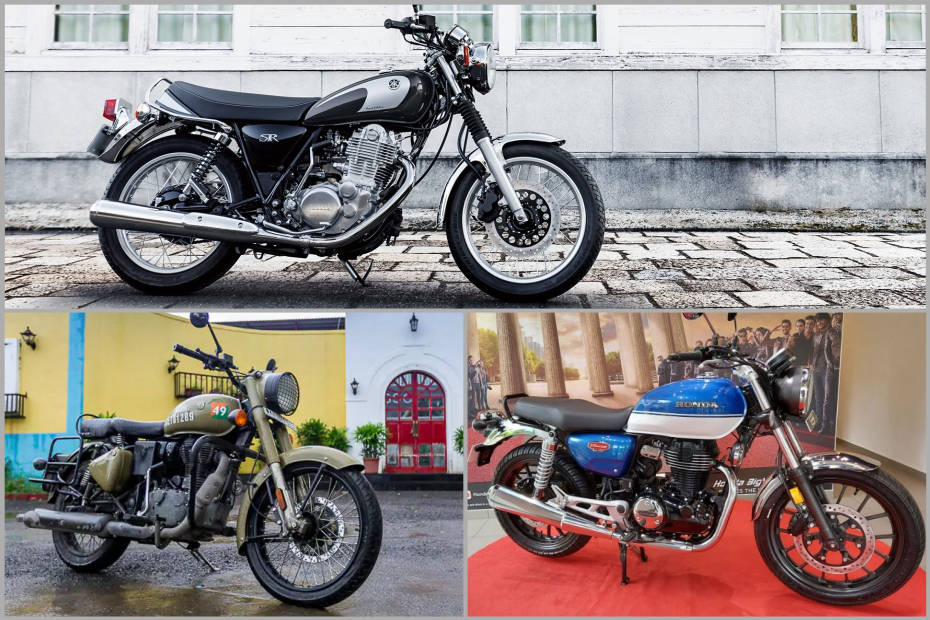Yamaha SR400 vs Royal Enfield Classic 350 vs Honda H’Ness CB350: Specifications Compared
Modified On Feb 8, 2021 09:38 PM By Praveen M.for Yamaha SR400
- 584565 Views
Japanese old school goodness vs Indian retro heavyweights: Which one is superior on paper?

After 43 years of its existence, Yamaha is bidding adieu to its famed retro roadster, the SR400, with the launch of its Final Edition in Japan. And if you’re wondering where it stands against Indian retro heavyweights like the Royal Enfield Classic 350 and the Honda H’Ness CB350 in terms of specifications, you’ve come to the right place.
Engine

Yamaha made sure that the engine of the SR400 remains as old school as possible, leaving just about enough room for the modern bits to make it legal. So, you get a traditional kick starter with a decompressor instead of an electric start. In contrast, the engine is fed by a modern fuel-injection system. Thanks to its bigger displacement, it is the most powerful of the lot. However, the peak power comes in very close to its redline, where you’re basically pushing the engine to its limits.
The Royal Enfield Classic 350’s motor is only slightly more modern, thanks to an electric start system. It is perfect for relaxed rides, with the needle sitting at 80kmph. Honda earns brownie points for being the most advanced engine of the lot, complete with a counterbalancer. This should go a long way in improving the bike’s refinement, especially at highway speeds. It even gets a traction control system, although it’s an overkill for a 350cc bike. Additionally, the assist function in the CB350’s clutch ensures the lever is light to operate and the slipper clutch prevents the rear wheel from locking up during aggressive downshifts. This will be a boon, especially while riding downhill.
Underpinnings

As far as the suspension is concerned, the gas-charged twin shock absorber setup along with the sprung seat in the Royal Enfield Classic 350 should offer superior damping on paper. The other two bikes manage with a telescopic front fork and twin rear shock absorber setup. When it comes to braking prowess, the Honda H’Ness CB350 clearly has the upper hand, thanks to the bigger front disc and standard dual-channel ABS. Being an old-school bike, the SR400 misses out on ABS. On the other hand, Royal Enfield offers either a single-channel ABS or a dual-channel one, depending on your budget. However, for the sake of safety, we’d recommend you go with the dual-channel variant.
Dimensions & Features

The longer wheelbase on the Honda H’Ness CB350 should give it better straight line stability. The bike also enjoys a generous ground clearance, which should come in handy on bad roads. However, shorter riders will find the Yamaha SR 400 easy to maneuvre, thanks to its low seat height and light kerb weight.
That being said, the Yamaha SR400 is as old school as it gets (in terms of features). There’s no ABS and neither a fancy console, just a good old twin-pod analogue setup. Even the Royal Enfield Classic 350 is as barebones as the Japanese retro (minus the ABS). On the other hand, Honda has provided all the modern bits like a detailed semi-digital instrument cluster with real-time mileage indicator, voice-activated turn-by-turn navigation system (DLX Pro only), and an all-LED lighting system.
Price & Verdict

The Japanese economy is quite different from ours, so the Yamaha SR400 may sound expensive when converted to Indian rupees. Between the Royal Enfield Classic 350 and the Honda H’ness CB350, the former makes sense for those under a tight budget. But if you want a riding experience that's just the right balance of laidback old-school vibe and modern usability, the CB350 is the one for you. However, you need to be aware that it is only available in cities where Honda’s premium BigWing dealerships are present.
And if you’re really keen on owning a retro bike from Yamaha, you might want to wait for the Yamaha XSR155. You can read more about the reasons why it should come to India here.
